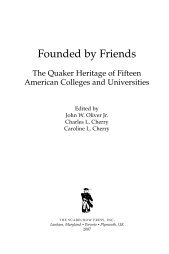Historical Dictionary of Lesbian Literature - Scarecrow Press
Historical Dictionary of Lesbian Literature - Scarecrow Press
Historical Dictionary of Lesbian Literature - Scarecrow Press
Create successful ePaper yourself
Turn your PDF publications into a flip-book with our unique Google optimized e-Paper software.
INTRODUCTION • xxxv<br />
ships with each other. Lister describes both romance and sex in detail.<br />
She also documents her life as the transgender figure <strong>of</strong> a country<br />
squire. The publication <strong>of</strong> Lister’s writings pushed back the historical<br />
date at which scholars are willing to imagine something like a contemporary<br />
lesbian identity. It is significant, however, that this identity existed<br />
in carefully guarded, upper-class subcultural groups. Economics<br />
are a central and <strong>of</strong>ten overlooked factor in the possibility for lesbian<br />
expression in culture.<br />
Mid-19th-century literature, at least in the middle- and high-brow arenas,<br />
was clearly more sexually conservative than 18th-century literature.<br />
A kind <strong>of</strong> conservative backlash was fed by Europe’s developing idea<br />
<strong>of</strong> itself as the moral center <strong>of</strong> a Christian empire. Still, penny dreadfuls<br />
and popular ballads, as well as a thriving pornography industry, kept<br />
sexual inquiry alive, and found a willing audience. Until the end <strong>of</strong> the<br />
century, English fiction <strong>of</strong> the middle and upper classes was dominated<br />
by the 19th-century realist project, spearheaded by Jane Austen in direct<br />
response to the decadence and frivolity <strong>of</strong> Gothic literature. Within this<br />
fiction, however, the tradition <strong>of</strong> female romantic friendship continued<br />
and developed. Charlotte Brontë’s Jane Eyre and Villette both describe<br />
intense romantic friendships between young women. Nineteenth-century<br />
women’s poetry began a tradition <strong>of</strong> passionate expressions <strong>of</strong> love and<br />
desire between women. Christina Rossetti in England and Emily Dickinson<br />
in the United States are two examples here. The two English<br />
women writing together as Michael Field embodied a lesbian identity in<br />
both life and work. Evidence suggests that they were aware <strong>of</strong> this to<br />
some degree at least, that is, that they viewed their relationship as something<br />
more contentious than romantic friendship. In the 1860s, sensation<br />
fiction in Great Britain began to anxiously explore questions <strong>of</strong> female<br />
sexual identity and agency, though it rarely, if ever, suggested<br />
lesbianism directly.<br />
In France, decadent literature continued to explore female gender<br />
transgression and same-sex desire. In 1835 both Théophile Gautier’s<br />
Mademoiselle de Maupin and Honoré de Balzac’s The Girl with the<br />
Golden Eyes were published. By the 1880s both Guy de Maupassant<br />
and Emile Zola were creating recognizably modern lesbian characters.<br />
These women lived independent lives, transgressed the boundaries <strong>of</strong><br />
feminine passivity, loved each other physically and emotionally, and <strong>of</strong>ten<br />
cross-dressed. The cross-dressing bisexual French novelist George
















